Tempeh Lemon Curry
I know I haven’t been around for a while but, hey!, I’m still here, and today we’ll talk curry. I realize this is the first curry recipe I write about on the blog, and to be honest I don’t know how that happened because it’s the kind of dish I cook often. I know there are a lot of vegetable curry recipes on the internet and that you probably don’t need another one, but I’ve made this curry countless times and think it’s a good one to have on your repertoire.
The variations in here could be endless. I’ve made it before with spinach in place of the cabbage and it turned out good, but I prefer to use the latter mainly because of the texture it brings to the whole thing. A word on tempeh: it’s well known that steaming tempeh for 15 minutes before actually cooking with it, removes its bitterness. To be honest, I don’t mind the bitterness and I think it goes practically unnoticed in here, camouflaged by the bold flavours of all the spices and the lemon. Having said this, if you want to steam it first (or even sub it for tofu), go ahead.
Enjoy the curry, have a great summer (guess what: here in Portugal has been raining) and I promise to come back soon! (:
Tempeh Lemon Curry
(serves 4)
3 Tbs. olive oil, divided
1 large onion, finely chopped
4 garlic cloves, finely chopped
1 tsp. ground coriander seeds, roughly pounded in a mortar and pestle
1 tsp. mustard seeds, roughly pounded
1 tsp. caraway seeds, roughly pounded
2 medium carrots, cut into cubes
1 Tbs. fresh ginger
1 tsp. ground turmeric
1 red chilli, finely chopped
1 large zucchini, cut into half moons
1 cup / 250 ml coconut milk
4 cups shredded cabbage
250 gr tempeh, cut into cubes
½ teaspoon
1 tsp. rice syrup
2 Tbs. mirin
zest of one lemon
1 handful toasted cashews, coarsely chopped
1 handful fresh mint, coarsely chopped
juice of ½ lemon
In a large pan over medium heat, add 2 tablespoons of olive oil, onion, garlic cloves and coriander, mustard and caraway seeds. Fry for 3-4 minutes or until the onion has softened and the spices have toasted a bit and smell fragrant.
Add the carrots, fresh ginger, turmeric, chilli and zucchini to the pan. Give everything a good stir and add the coconut milk. Cover the pan and cook for 5 minutes.
In the meantime, heat the remaining 1 tablespoon of olive oil in a frying pan over medium-high heat. When the oil is hot, but not smoking, add the tempeh cubes and fry until golden brown. Turn off the heat, sprinkle the tempeh with a pinch of salt and add it to the pan with the vegetables.
Now, add the cabbage to the pan as well, pressing it gently with the back of an wooden spoon so that it’s covered by the coconut milk. If, at this point, the curry looks as if it hasn’t enough liquid, add up to 1/3 cup of it, but keep in mind the cabbage will release a lot of water too. Cover the pan and cook for additional 5 minutes, or until the cabbage is wilted. Add the salt, rice syrup, mirin and lemon zest. Stir everything together and finish off with the lemon juice, toasted cashews and mint.
Recipe adapted from The Modern Vegetarian Kitchen, by Peter Berley, published by William Morrow Cookbooks, 2008
Simple Vegetable Stew with Homemade Seitan Sausage
Seitan used to be one of those things I’d eat on rare occasions, as I was never a big fan of its taste. I liked its meaty, slightly chewy texture, but I felt I never marinated or seasoned it the right way, as everytime I’d prepare it, it would end up tasting a bit too bland. The only way I could eat this source of vegetable protein would be on a spaghetti bolognese sort of dish, where I’d grind it and cook it in unreasonable amounts of tomato sauce. But then I’ve bought The Millenium Cookbook and I found out I could make my own seitan, and add to it as much flavor as I wanted to. The original recipe from the book, has curry and spices such as cumin and coriander as dominant flavors. I’ve made that recipe a hundred times around here, until I started playing around with it a bit more. The recipe for the seitan sausages I’m sharing with you today, has dried herbs and tomato sauce as “flavoring agents”, to make it more of a provençal-inspired sort of thing.
As far as the preparation goes, let me tell you that seitan making has no special technique at all, and I’m sure that if you attempt at making it, you’ll be surprised by how easy it is. On the other hand, I bet that by the time you’re preparing it, you’ll have a lot of other ideas on how to flavor it differently. I’ve made a couple of notes on that too: adding seaweeds such as dulse or wakame to the gluten dough could be interesting, as well as finely cut vegetables, for a more distinct texture. On the same hand, I bet that adding a coulpe of drops of liquid smoke to the dough, would definitely please even the most conservative meat eaters out there. I added the sausages today to this simple vegetable stew, but feel free to try these in pasta sauces, pizzas, or in whatever dish you might think they’re a good addition to. The possibilities are endless, really, and I’m sure you can come up with better ideas for using it than I do. ; )
Update: Trudy, from VeggieNumNum, has made a wonderful version of these seitan sausages. You can find her version, as well as other stunning veggie recipes here.
Simpe Vegetable Stew with Homemade Seitan Sausage
For the Seitan Sausage
(makes 4 sausages)
2 cups (250 grams) gluten flour
1 teaspoon salt
2 fat garlic cloves, minced
1 large white onion, cut in half
¼ cup olive oil
1 cup water
4 cups light stock
3 tablespoons tamari
4 tablespoons tomato paste
1 teaspoon dried thyme
1 teaspoon dried oregano
1 teaspoon dried chives
1 teaspoon dried parsley
1 teaspoon garlic powder
½ teaspoon paprika
4 pieces of cheesecloth of 30×30 cm each (note: make sure the holes of your cheesecloth are very close. otherwise, you might have to double or triple the amount of cloth used)
1. In a large bowl, combine the gluten flour, dried herbs, garlic powder, and salt.
2. In another bowl, mix 1 cup of water with the olive oil, tomato paste, and 1 tablespoon of the tamari.
3. Slowly add the wet mixture to the dry mixture, and mix until you have a firm and elastic dough. Kneed the dough for 5 minutes, making sure there’s no flour left on the bowl.
4. Divide the dough into 4 equal portions. With your hands, roll out each portion into a log about 8 centimeters long, but don’t worry if it doesn’t look perfectly shaped - while cooking, the sausages will plump and get a perfect cilindric shape.
5. Cut 8 pieces of kitchen twine of about 6 centimeters long each. Place a piece of cheesecloth in your table or kitchen counter, and roll it tightly around one piece of the dough. Tie the ends of the sausage with kitchen twine (using one of the cut pieces for each end), to seal the sausage in the cheesecloth - it’s important that the dough is really tight and properly sealed, or it might fall apart while cooking. Repeat this proceeding with the remaining pieces of dough.
6. In a large pan, add the 4 cups of stock, garlic cloves, onion, and 2 tablespoons of the tamari, and bring the liquid to a boil. Then, add the sausages. Reduce the heat to low-medium and simmer, covered, for 40 to 45 minutes, or until the sausages are cooked through. Discard the onion and garlic cloves.
7. Remove the sausages from the pan, let them cool, and carefully remove the cheesecloth. The sausages will keep, stored in an airtight container with the cooking liquid, for up to 1 week.
For the Vegetable Stew
(serves 4, generously)
1 large aubergine, cubbed
1 large zucchini, cubbed
1 medium sized red bell pepper, thinly sliced
2 fat garlic cloves, minced
1 tablespoon coriander seeds
2 teaspoons red chili pepper, minced (with seeds)
1 large ripe tomato, peeled, seeded, and cubbed
1 and ½ seitan sausages (about 200 grams), sliced into rounds
2 tablespoons olive oil
¼ cup red wine
4 tablespoons tomato sauce (canned is fine)
salt and pepper to taste
chopped coriander, for garnish
1. With the help of a mortar and pestle, crush the coriander seeds.
2. Heat the olive oil in a large pan over medium heat, add the garlic, chilli, and coriander seeds, and fry for 1 to 2 minutes, or until fragrant.
3. Add the zucchini, aubergine, and tomato cubes, as well as the wine and tomato sauce, and simmer, covered, for 15 to 20 minutes, or until the vegetables are soft and slightly overcooked. Add the seitan sausage, give the stew a good stir, and cook for additional 5 minutes.
4. Add salt and pepper to taste and serve immediately, garnishing each serving with chopped coriander.
The recipe for the homemade seitan sausages is inspired by the Millenium Cookbook, published by 10 speed press, in 1998
Curried Zucchini and Apple
This recipe is what I had for lunch today, alongside some grilled tofu and toasted bread slices. It’s one of those recipes that you can put together in a matter of minutes, and is really tasty. What is important in here is to slice both apple and zucchini as stated in the directions, so that they cook thoroughly in the amount of time I’ve specified. The point is to just slightly overcook the zucchini, while the apples retain some of their crunchiness (one of the reasons why I haven’t peeled them). Also, you don’t to use tart apples such as, for instance, Granny Smith, but sweet and crisp ones, as a way of balancing the addition of lemon and ginger juices to the dish. For me, Starking apples work the best in here, but if you can’t find them, I bet Red Delicious would make it as well. For some of you who don’t really know what else to do with zucchini, give this recipe a shot – I’m almost sure it won’t disappoint.
Curried Zucchini and Apple
(serves 4, as a side)
540 grams zucchini (3 medium ones)
200 grams Starking apples (2 small ones)
2 garlic cloves, minced
2 tablespoons olive oil
1 teaspoon curry powder
2 tablespoons water
1 tablespoon freshly squeezed ginger juice
1 and ½ tablespoons freshly squeezed lemon juice, plus a bit more
1 tablespoon lemon zest
¼ cup toasted almonds, coarsly chopped
1 small handful of chopped coriander
salt and pepper to taste
1. Quarter the zucchini lengthwise. Then, cut each quarter into two halves. Finally, cut each half crosswise into sticks about 8 centimeters long. Set aside.
2. Quarter the apples and remove their core. Slice each quarter into 3 equal pieces, about 0,5 centimeters thick. Transfer the apples to a bowl, and add a squeeze of lemon juice to them, to prevent oxidation.
3. In a large sautée pan over medium heat, add the olive oil, garlic cloves, and curry powder, and fry for 1 minute. Add the zucchini and the 2 tablespoons of water, cover, and cook for 8 to 10 minutes, stirring occasionally.
4. Add the apples to the pan and cook for additional 5 minutes. In the last minute of cooking, add the lemon and ginger juices, the lemon zest, and season well with salt and pepper.
5. Remove from heat and divide among 4 deep plates. Add the almonds and chopped coriander on top of each serving and serve immediately.
inspired by Vegetarian Cookery, published by Dorling Kindersley, 1991 (I believe the book is now out of print)
Ratatouille Soup
When it comes to food, I’m not a purist. That being said, I have no problems eating canned beans or store bought cookies, as long as they’re vegan and taste good (although, quite frankly, I often cook my beans and bake my cookies). I generally don’t have “prejudices” against canned stuff, and if there are canned produces I use on a regular basis, they are tomato sauce and roasted peppers. They’re vegan, taste good, and although it’s often said there’s nothing as homemade tomato sauce, I’m totally sold to the canned one.
When it comes to recipes, specially traditional and local ones, I’m also not a purist. I do believe moussaka is not the same without meat in it, but I do really enjoy my dairy-free version of the greek classic; the same goes for pizzas and lasagnas, foods that usually call for cheese, and that I most of the times make cheese-less. Actually, both vegans and vegetarians end up, most of the time, tweaking recipes to get them to fit their diets, and that often means to make a traditional dish the unconventional way. This whole process of tweaking recipes fascinates me, as that doesn’t mean they’ll loose their former character just because they’re made a little different by some vegans and vegetarians out there. For me, respecting the identity of a certain local recipe (I’m thinking of portuguese traditional foods by the way), doesn’t mean you have to make it exactly as people did a hundred years ago. Time has passed, dietary needs have changed thanks to our growing knowledge on nutrition and health issues; and I feel it’s by tweaking and experimenting with flavors, textures and so on, that you keep the spirit of traditional foods alive nowadays, more than sticking to the way they’re – traditionally speaking - supposed to be made.
I found myself thinking about all this because of today’s recipe. Ironically, a recipe inspired by a french dish that is already vegan. There is much debate on how to make traditional ratatouille, but I don’t really want to contribute to the discussion. My version of it calls for canned tomato sauce and canned roasted bell peppers, as it saves up some time, being therefore more user-friendly, but if you want to make everything from scratch, just go ahead. Also, by adding far more liquid than it’s usually added on a stew, I make more of a soup, rather than a side dish. This ratatouille soup, alongside with a good slice of toasted wholegrain bread, makes for an excellent comforting meal, perfect for the autumn days to come.
Ratatouille Soup
(serves 6)
300 grams aubergine
300 grams zucchini
3 medium size tomatos, coarsly chopped
2 roasted bell peppers, coarsly chopped
3 garlic cloves, minced
2 tablespoons olive oil
½ red chili pepper, finely cut
½ teaspoon dried thyme
½ teaspoon dried oregano
1 cup plain tomato sauce
½ cup red wine
1 1/2 cups light stock
1 bay leave
salt and pepper to taste
1. Start by preparing the aubergine and zucchini: slice both vegetables into 0,8 cm thick rounds, and then cut each round into 4 equal pieces. Set aside.
2. In a large pan over medium heat, add the olive oil, garlic, chili, dried thyme, oregano and bay leaf, and sautée for 2 minutes. Add the tomatos and roasted bell peppers and cook for 5 minutes, stirring occasionally.
3. Now, add the stock, red wine, and tomato sauce to the pan, and cook for 10 to 15 minutes, or until the tomatos start breaking down and you get the consistency of a thick, hearty sauce.
4. Discard the bay leaf. Transfer the pan to your counter or kitchen table, and with the help of an immersion blender, blend the mixture until smooth.
5. Return the pan back to the stove, add the zucchini and aubergine, and cook, over low-medium heat, for at least 25 minutes, maybe a bit a longer – the point here is to slightly overcook the vegetables. Add salt and pepper to taste.
6. Serve the soup hot or at room temperature – it’s particularly good alongside a slice of wholegrain bread - bearing in mind it will thicken in the hours to follow the end of the preparation.
Seasonal Minestrone
Surprisingly enough, yesterday - with an outside temperature of 35 degrees -, I found myself sneezing and coughing all the time. I knew I was about to get sick, and started craving a comforting soup and toasted bread, no matter how hot was outside and how sweaty I’d get right after eating those foods. I had some seasonal veggies sitting on the fridge that would make for a good pot of soup, and it didn’t take me long to get my hands at preparing them (peeling, slicing and all), although I must confess I was about to give up a few times during the process and go for a nap. I’m usually very determined when it comes to satisfy my cravings, and the idea that, in the end, I’d get a huge pot of soup that would make my lunches and dinners for the rest of the week, worked out as the main motivation factor.
I ended up following (although not stricktly) Jamie Oliver’s recipe for a Spring and Summer Minestrone, that I’ve bookmarked from his book Jamie Does. I adapted the recipe to fit what I had on hand, and I guess that’s the spirit of minestrone anyway – use whatever vegetables are in season and that would go well together for a hearty, filling soup. The original recipe for the pesto calls for Parmesan, but as I don’t do cheese, I’ve just ommited this ingredient and had not problems at all. Just bare in mind Parmeasan is quite salty, so use a good pinch of salt in the pesto to work as a substitute and to balance things out.
Seasonal Minestrone
(serves 6)
200 grams carrots
300 grams zucchini
3 garlic cloves
1 large leek
1 large tomato
a bunch of parsley
2 handfuls watercress
1 cup frozen peas
150 grams short pasta
1 small cabbage
2 liters good tasting stock
salt and pepper
olive oil
for the pesto:
a bunch of basil
60 grams pinenuts
3 tablespoons olive oil
2 small garlic cloves, peeled and thinly sliced
a pinch of salt
1. Start by preparing the carrots and zucchini: slice each vegetable into quarters, and then slice each quarter into cubes of aproximadetely 0,8 to 1 centimeter thick.
2. Then, thinly slice the leek and garlic cloves.
3. Heat your largest pan on medium heat, add a few glugs of olive oil, the leek, garlic, carrots and zucchini. Stir and cook for about 5 minutes.
4. Roughly chop the tomato, parsley, and watercress. Slice the cabbage into halves, remove the hard core, and finely shred each half. Add the veggies to the pan.
4. Now, add the peas, pour in the stock, and bring to a boil. Once boiling, add the pasta and salt and pepper to taste. Lower the heat to low-medium, and let the soup simmer for about 10 minutes, or until the pasta is cooked. Taste and adjust the seasonings if needed.
5. To make the pesto, add the basil, pinenuts, garlic cloves, a pinch of salt and the olive oil to a food processor, and pulse everything for 1 minute, or until the mixture starts coming together into a paste, but isn’t totally smooth. Have a taste and adjust the flavors (adding a bit more of one or another) if needed, bearing in mind you want to find a balance between all the ingredients.
6. Divide the soup among deep plates and top each serving with a good tablespoon of pesto. Drizzle over a little olive oil and add some fresh basil leaves.
recipe inspired by Jamie Does, published by Penguin Books
Peas, Lentils and Zucchini Salad
Quite often, when I flip through the pages of a cookbook I have for quite some time, I get surprised to see recipes in there that I never payed attention to before. Usually, those are recipes with no images attached, and I think that’s the reason why I (unpurposely) pass them. Today, as I was flipping through Moro East (a cookbook I turn to over and over again), I noticed the shy presence of a recipe titled Peas and Lentils. It immediately caught my attention, as I never though of pairing those two ingredients. As I was reading through the recipe, I realized it also called for sage and mint. I didn’t have sage on hand (besides mint, there was only a bunch of parsley sitting on my fridge), so I decided to substitute the tablespoon of chopped fresh sage they called for in the recipe, for an additional tablespoon of mint. For some reason I can’t rationally explain, it seemed to me that mint and parsley wouldn’t go very well together, hence my decision in keeping mint as the only herb in the salad, relying on the success the combination of peas and mint always is.
But the combination of peas, mint and lentils is even better. The nutty taste of puy lentils balances the sweetness of the peas, and the addition of mint adds a fresh, summery flavor. In my version, I added sautéed zucchini to the salad not only because I had a lot of zucchini on hand (it seems everybody’s having this very same “problem” this time of the year), but also because, cooked this way, zucchini is very versatile and make a nice appearance in any salad. If you’re going to make this, I advise you not to substitute the puy lentils for any other kind of lentils, as puy keep their structure and a little bite after being cooked, unlike regular brown lentils, that tend to go mushy and fall apart.
Pea, Lentil and Zucchini Salad
(serves 3, as a side)
90 grams (1/2 cup) puy lentils
150 grams (1 cup) frozen peas
one large garlic clove, minced
300 grams zucchini (a large one), topped, tailed, and cut into thin rounds
1 tablespoon olive oil
a pinch of salt
2 tablepsoons roughly chopped mint
for the dressing:
3 tablespoons olive oil
1 and ½ tablespoons red wine vinegar
a pinch of sugar
1. In a medium size pot, bring 3 cups (750 ml) of water to a boil and add the lentils. Cover and cook, over medium heat, for about 20 minutes, or until just tender. They should be firm, as it is important that they keep their structure. Drain the lentils, refresh under cold water, drain again, and put them in a large bowl.
2. At the same time the lentils are cooking, boil the peas (2 cups – 500 ml – of water is enough) for about 4 minutes. Drain, refresh under cold water, and mix them with the lentils. Add a pinch of salt, toss well, and set side.
3. Heat your largest skillet over medium-high heat, add the olive oil and gralic and fry for one minute.
4. Then, arrange the zucchini rounds in a single layer on the skillet. If your skillet isn’t large enough, you may want to do this in two batches. Add a pinch of salt and cook the zucchini for a few minutes until browned. Turn over, one by one, and cook the other side for a few more minutes, adding a bit more salt. When you’re done, transfer the zucchini to the large bowl in which you combined the peas and lentils.
5. To make the dressing, combine, in a bowl, the olive oil, vinegar, and sugar and mix well.
6. Add the dressing and mint to the salad and toss well. Serve immediately.
inspired by Moro East, published by Ebury Press
Zucchini and Potato Salad
More than two weeks ago, I ordered some new cookbooks. In the past couple of days, I’ve been getting anxious at around 11 a.m, the hour at which the over-sized shipments are delivered by hand on my neighborhood. It happens that mine haven’t arrived yet, so now I started considering the hypothesis that they might have got lost on their way from the UK to Portugal. It already happened a few times with other items I’ve purchased, and it’s kind of annoying. But, anyway, as I don’t have yet the new cookbooks, I’ve turned to the “old” ones I’ve got at home and have been exploring them intensely. And if there’s one cookbook that I’ve been really cooking a lot from, that is Bryant Terry’s Vegan Soul Kitchen . When I first got it, I was slightly disappointed by its layout. I thought the design of the book was not particularly appealing, which was a pitty, because it didn’t let Bryant’s recipes shine as they deserved. But despite its design, Vegan Soul Kitchen is by far one of my favorite cookbooks. It’s filled with unique, vibrant recipes, from cover to cover, and I love the fact that Bryant gives both film and music recommendation for each recipe on the book. It’s actually a pretty cool thing because of two particular reasons: firstly, I get to know a lot of music and film through a cookbook, which is something untypicial and original for a cookbook; and secondly, because it gives me some insights on Bryant’s creative process, which I admire because of its interdisciplinarity (by taking inspiration from art and music to create and develop his own recipes).
There was this Crispy Green Beans Salad on the book that I wanted to try. But here in Portugal we’re not in green beans season right now, so I decided to adapt the recipe to what I have bought on the market this morning. And thus a whole new recipe was born - the Zucchini and Potato Salad. In here, I grilled the zucchini until it got good grilling marks, and boiled the potatoes with their skins on until they were soft and tender; tossed everything in a large bowl with some roasted shallots and a garlicky mustard dressing, and served with sprigs of fresh lemon thyme and toasted walnuts. Instead of boiling the potatoes as I did, I think you could also cut them in small cubes and pan fry them until gold and crisp, and then proceed with the following steps.
Ingredients:
(serves 4, as a side)
335 grams small potatoes (about 15 potatoes)
400 grams zucchini (2 small ones)
4 large shallots
olive oil
salt
1 tablespoon balsamic vinegar
1/4 plus 1 tablespoon toasted walnuts
for the mustard vinaigrette:
1/4 cup lemon juice
2 tablespoons red wine vinegar
2 teaspoons dijon mustard
3 teaspoons agave nectar
2 large garlic cloves
1/3 cup olive oil
1 tablespoon lemon thyme, plus a bit more for garnish
salt to taste
1. Preheat the oven to 180ºC.
2. I used very small potatoes in here, not that much bigger than the size of a grape, so if yours aren’t that small, cut them in halves and do not remove the skins. Bring about 2 liters of water to a boil, add 1 tablespoon of salt and the potatoes. Let them cook for 15 to 20 minutes. Drain them and wash them under cold running water. Drain again and set aside.
3. Trim the ends of the zucchini and cut them into 1 centimeter thick rounds. With a pastry brush, brush each round with olive oil and add about 1/2 teaspoon of sea salt (to all the rounds, not to each one individually). Heat a grill on maxium heat, add the zucchini rounds, and cook them for about 3 minutes on each side, or until they get good grilling marks. Remove from heat, let them cool, and set aside.
4. In a medium-size bowl, toss 1/2 teaspoon of salt, 1 tablespoon of olive oil and the balsamic vinegar. Rub this mixture in the shallots (with their skins on). Place the shallots in a baking dish lined with parchment paper, and roast them in the preheated oven for about 1 hour or until their skins have almost blacken. Let them cool, transfer to a cutting board, and take off their skins. Now, cut them into 2 centimeter thick pieces.
5. In a blender, combine all the ingredients for the vinaigrette except the olive oil. While the blender is still running, slowly pour in the olive oil. Have a taste and adjust the seasonings - a bit more salt? a bit more agave? - if needed.
6. In a large bowl, combine the potatoes, zucchini and shallots. Add about half of the vinaigrette and toss well.
7. Transfer all the ingredients to a big platter, add the toasted walnuts and some fresh lemon thyme sprigs. Right before serving, drizzle with the remaining vinaigrette.
recipe inspired by Vegan Soul Kitchen, by Bryant Terry, published by Da Capo Press
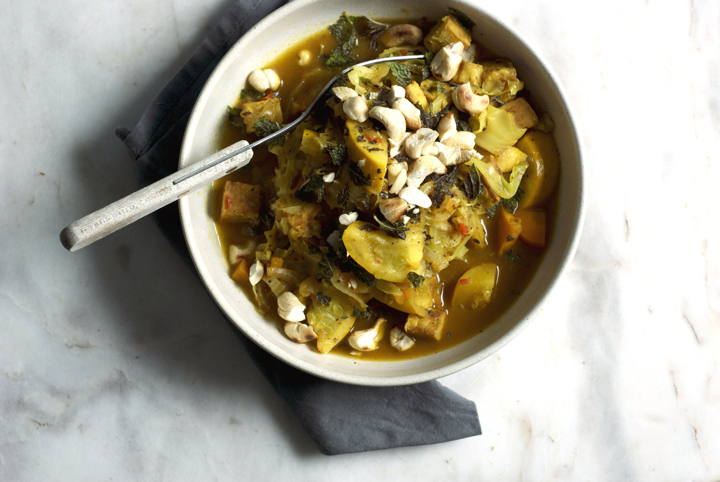
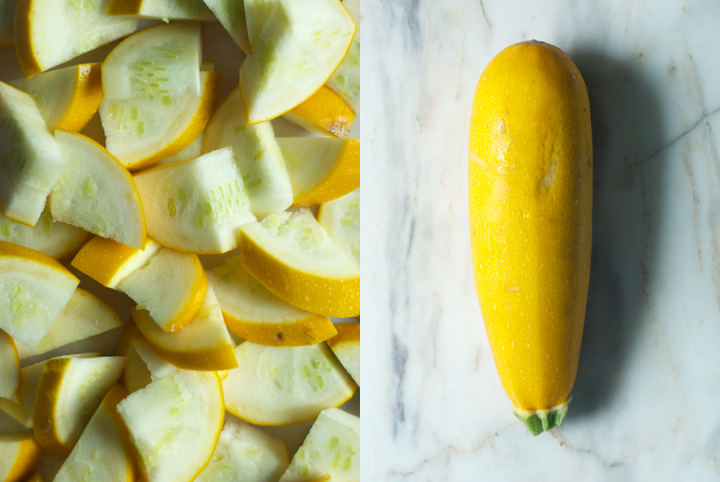
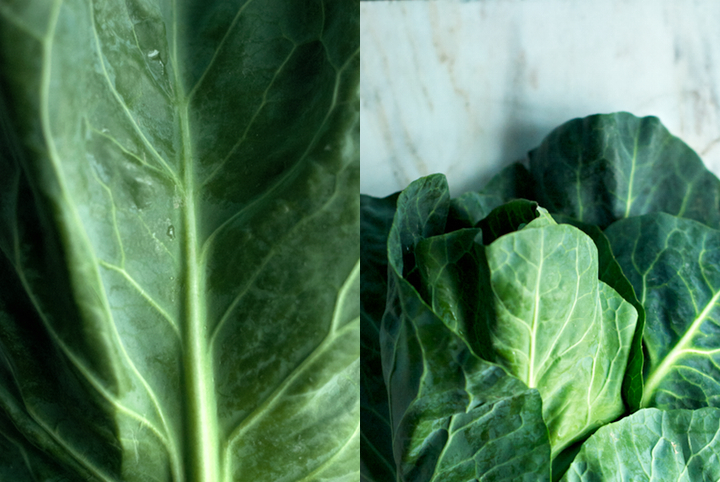
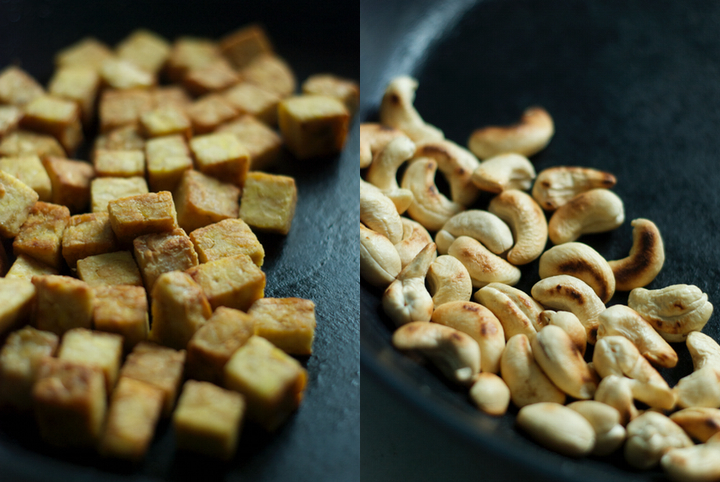
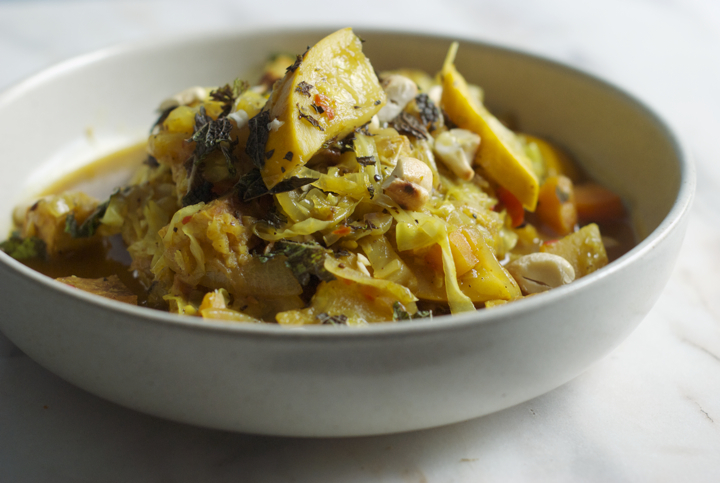
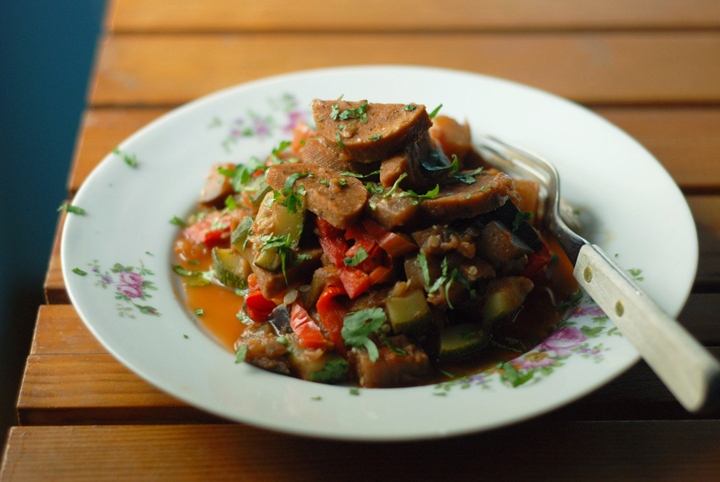

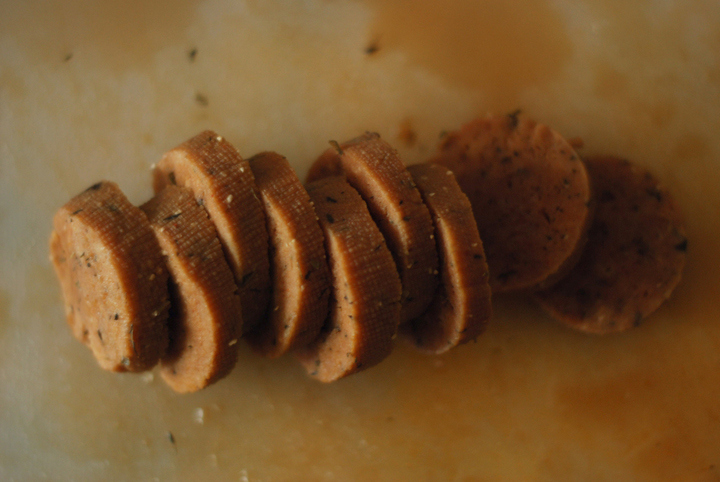
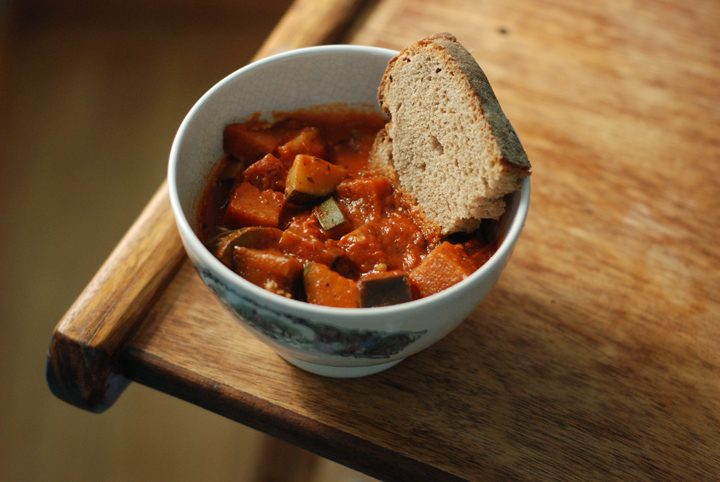

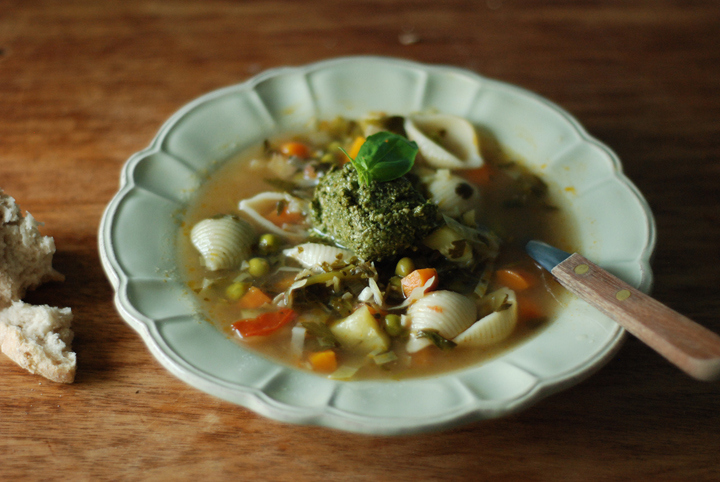
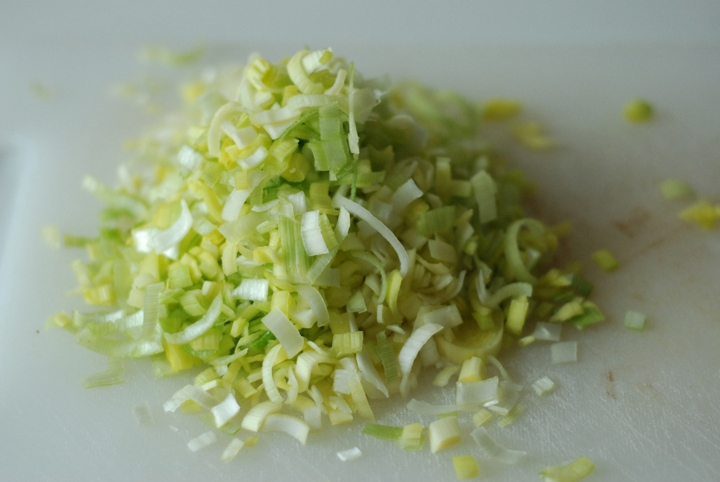
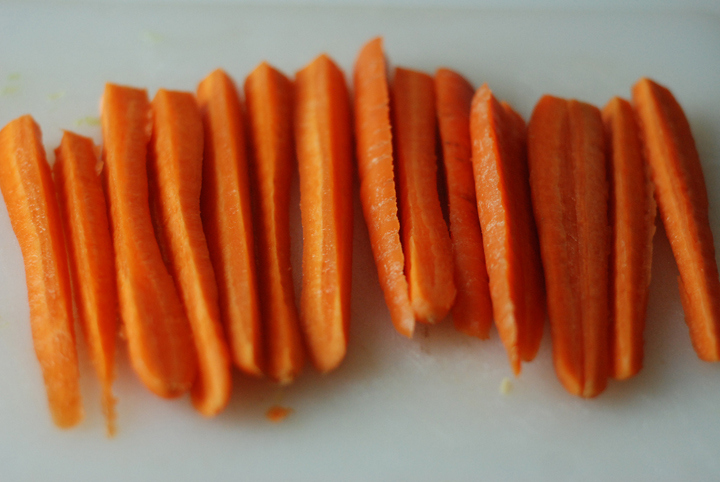

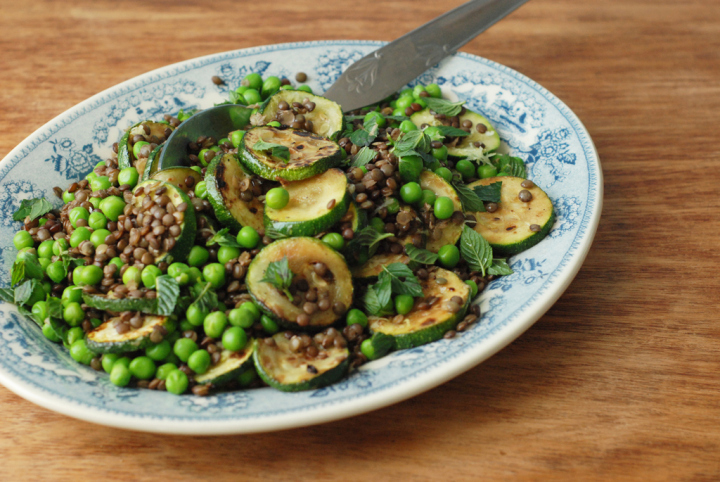
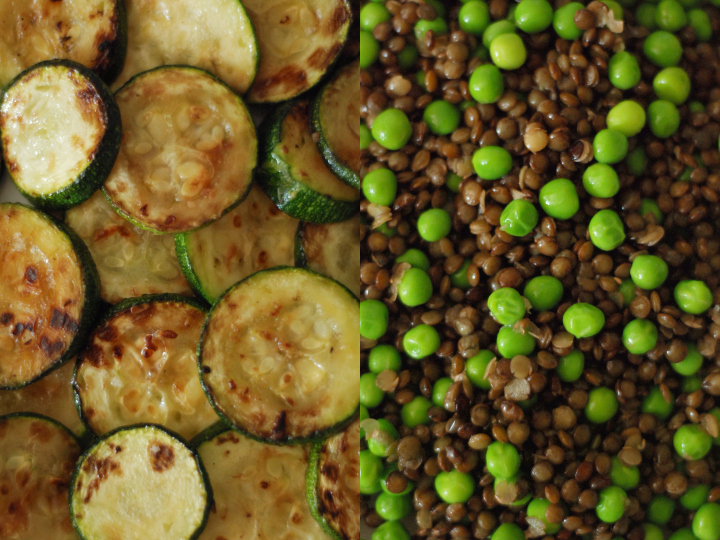
1 comment